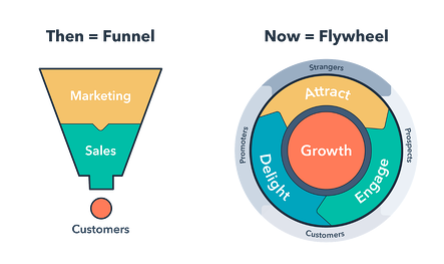Top 5 B2B Marketing Trends to Watch in 2023
Get news & insights direct to your inbox.
In the words of the Greek philosopher Heraclitus, “Change is the only constant in life.” This statement is particularly true in the marketing world, which is continually evolving but with one important constant – the need to maintain relevancy and create an authentic connection with audiences. In this article, we’ll take a look at the top 5 marketing trends B2B organizations can leverage for success in 2023.
Recent trends of economic uncertainty are anticipated to continue throughout the year, causing businesses to take a close look at their operations and consumers to take a more discerning approach to their decisions. More than ever, it will be necessary for brands to be transparent in their messaging and to utilize research-based strategies. It also means that marketers must stay ahead of these trends and plan to adapt rapidly and regularly, particularly for business-to-business organizations.
Here are our picks for the top 5 B2B marketing trends to watch and adapt in 2023:
1. Blending Sales & Marketing Teams
Despite working towards the same or similar goals, marketing and sales teams are often siloed and operate as vastly different departments within an organization. According to a survey conducted by Hubspot, 1 in 5 marketers struggle to share information across sales and marketing teams. This segmentation makes it difficult for teams to share data, synchronize on strategy, and, most importantly, understand the true performance of their collective efforts.
When both sales and marketing teams are aligned, marketers can compile an accurate picture of customers and their needs, which allows for the creation of more successful and fulfilling campaigns that, in turn, support sales team goals. Understanding the impact a blended approach can have on goal fulfillment, many business leaders are working towards combining and even blending sales and marketing operations.
Say “bye-bye” to the Sales Funnel and hello to the Flywheel

Image source: via Hubspot
The benefits of sales and marketing collaboration can be demonstrated in the shift from the traditional sales funnel to the flywheel model. Previously, the one-directional funnel that served as the guiding light for sales teams made customer acquisition the end goal. With the flywheel, there is no end, as sales is a perpetual process. Customers must continually feel appreciated and delighted to remain loyal in today’s competitive landscape. In the flywheel model, customers are the center focus, and marketing support to nourish customers and strengthen retention is emphasized. Today, the end goal is to turn customers into brand ambassadors, which further supports sales teams. In the coming year, we will see more brands utilize this model in their marketing strategies.
2. Doubling Down on Data & Insights
As the value of data increases, so do privacy concerns. Already in progress, the shift to Google Analytics 4 applies limitations on what user information can be tracked and reported. Additionally, sophisticated reporting tools and third-party tracking are phasing out to maintain consumer privacy.
What does this all mean for marketers trying to capitalize on valuable insights? Brands need to have heightened awareness of their presence in the market and put their data and insights to use in very strategic ways. One trend many B2C marketers are following is using creative analytics to make smarter design decisions that resonate better with audiences. Likewise, B2B marketers are taking a more scientific approach to building campaigns by doing more research and testing to identify where and how to connect with audiences.
Data Triangulation is the New Content Strategy
Researching and data collection can be both time-consuming and expensive. However, a practice marketers and UX strategists are adopting to address this is Data Triangulation. According to the Encyclopedia of Research Design, Data Triangulation is defined as “the practice of using multiple sources of data or various approaches to analyzing data to enhance the credibility of a research study.”
In summary, it means looking at a question from different or multiple points of view. In UX, triangulation can be seen in checking feature error rates, employing a survey to assess purchase motivation frequency, or holding a study to observe software use by team members. The more data and perspectives you collect, the easier it will be to adjust your strategy or product. Triangulation can also help you weigh expensive choices like redesigning a whole website versus incremental changes to improve the user experience.
3. Designing for Mobile First
Consumers are spending more time on mobile devices than ever before. In fact, more than half of all annual online website traffic comes from mobile devices. From websites to email and content consumed on social, brands need to adapt to meet audiences where they are.
Mobile-optimized digital experiences will be even more crucial to consider for business leaders looking to connect with younger generations or businesses that live and work primarily online. For marketers designing strategies and content, mobile will become a prime focus. For web developers, optimizing page load speeds and functionality of websites on mobile devices will be critical for businesses’ success in the immediate future.
4. Shifting Strategies
During periods of economic uncertainty, remaining adaptable and versatile will be essential for companies to maintain a competitive edge. However, these times can also unveil new opportunities as many companies will be more willing to take short-term risks or investments. Being able to shift and pivot strategies will be essential, as 2023 is positioned to be a pivotal year for B2B marketing.
As the surge in demand for data and technology to drive sustainability and efficiency in operations grows, B2B organizations will be in the spotlight as companies search for opportunities to alleviate economic strain and reach new markets. Likewise, marketers should look to increase operational efficiency by harnessing the power of automation to improve workflow and hyper-personalization. As business leaders seek to turn operations leaner and grow more reliant on technology, B2B marketers need to incorporate memorability into their messaging to capture and maintain the interest of opportunity seekers and “risk takers.”
While it is typical for consumer brands to invest in premium placement and unique-format creatives (like splashy commercials featuring A-list celebrities), we anticipate a shift in B2B advertising to create lasting impressions by leveraging channels typically reserved for direct-to-consumer marketing. Let’s not forget that B2B buyers are also human, and the buyer journey is as much about their personal experience as it is about the product offering. B2B marketers should leverage things like interactive web experiences, influencer marketing, and other experiential marketing tactics that make for a tremendous buying experience.
5. Building Communities through Content
There is an overabundance of content online, making engagement a critical metric to watch when assessing the effectiveness of any campaign. In 2023, brands should look to create content that builds communities and inspire engagement.
Consumers are seeking community and authentic human connection. They are more interested in the values and ethos of a brand when evaluating an offering, as they want to align their purchase with their values. Clear and thoughtful positioning of an organization’s values is key to capturing interest. 89% of marketers who created a content plan with a focus on social responsibility in 2022 and saw positive results plan to increase or maintain their investment in 2023. Social responsibility, ethics, and transparency will remain valuable to content strategies that endeavor to drive awareness, engagement, and maintain loyal audiences.
When designing your content strategy, it is essential to remember that 47% of buyers view three to five pieces of content before engaging with a sales rep. Successful marketing strategies include a content plan that incorporates a variety of formats, specifically long and short-form video, as it is still the best performing across all platforms. Additionally, long and short-form articles and blog posts are vital for improving SEO and building credibility. Brands should consider tapping satisfied customers for case studies, which are proven to drive leads and inquiries, and podcasts which are a valuable medium for brands looking to build communities.
While staying updated with the latest trends may feel intimidating, being informed and adaptable is crucial to your marketing plan’s success. We hope your organization can apply these tips to your strategy in 2023.
Subscribe to our newsletter and follow us on LinkedIn for the latest news and marketing insights that can impact your business.
